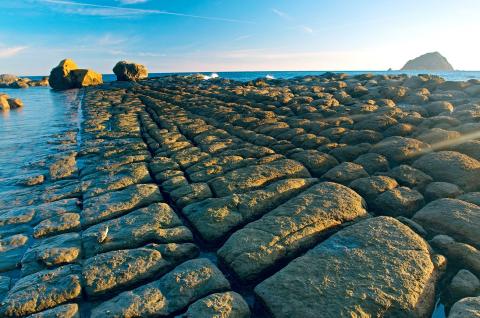The Hoping Island Beach Park, with its vast expanse of “senjojiki” and mushroom-shaped rocks, offers a geological treasure trove for both academics and residents of the Keelung area. However, Keelung locals and environmental groups have said that the park is not being adequately protected, pointing first to a 1,000 ping (3,300m2) wastewater treatment plant that was finished in 2008 and also to an incident in which four junior-high students ruined one of the mushroom-shaped rocks “just for fun” in March this year.
Parts of what is now the park had been under military control for a long time, which meant that people were banned from the area. However, after the ban was gradually lifted in the 1960s and 1970s, more tourists began to explore the vulnerable coastline. Parts of the park were closed for the past three years while renovation work was undertaken and the entirety of the park was opened to the public in June this year.
The “Back Garden,” as locals call the park, is no longer the trash-littered place it once was and the protection of the park has been outsourced to a security and management company.

Photo: CNA, courtesy of Chen Chien-chih.
However, the company’s chief executive, Chen Chien-chih (陳建志), says the firm remains helpless in the face of the damage being done to the park’s unique geological formations and that its employees could do nothing beyond asking tourists not to damage the area, but have no actual powers to stop them.
The island park’s scenery is phenomenal and it is possible to see many geological wonders within the 20-minute round-island hiking trail, Chen said.
The vast expanse of flat square rocks which have been carved into the rocky beachhead resembles thousands of Japanese tatami mats placed on top of one another, which is why the coastal feature has been named senjojiki — literally meaning thousands of tatami mats atop each other, Chen said.
Chen also said seawater has crafted the rocky formations by eroding the tiny joints within the rocks and has, over many years, cut a chessboard-like maze of small squares into the flat rock, resembling chunks of tofu.
Chen said the park affords tourists and visitors a fantastic view of the Keelung coastline, which lies across the strait separating the island from the mainland.
“We plan to build a number of elevated walkways or maybe change the radar stations — which were left over from the period when the island was under military control — into viewing platforms for tourists,” Chen said.
However, Chen said the park lacks infrastructure and other equipment, adding that there was also a shortage of tour guides.
“We need to build a pathway that keeps the tourists from actually touching the ground, something akin to the scenic routes in Yehliu Park — only then can we be certain that we are protecting the park’s geological formations while letting tourists get closer to nature,” he said.
According to Keelung City Government’s Department of Transportation and Tourism, the park is considered “land for park use” and any damage the island suffers must be dealt with as part of the legal framework within Keelung’s Regulations on Park Management and Autonomy (公園自治條例).
However, the punishment for infractions is light and it is difficult to gather evidence, making it hard to effectively stop vandalism within the park, the department added.
Pointing out that Yehliu is now included within the North Coast and Guanyinshan National Scenic Area boundaries, the security and management company charged with protecting the area said that famous scenic sites such as the Queen’s Head Rock Formation (女王頭) enjoys round-the-clock security guards. The Yehliu park has also introduced a system of guard stations to prevent tourists from climbing on and damaging the geological formations within the park, and the guards can fine tourists under the Tourism Development Act (發展觀光條例).
The act stipulates that anyone inflicting irreparable damage to a touristic or scenic spot can be fined as much as NT$5 million (US$167,300).
Despite the setbacks, the department says it is beginning to address the issue, adding that the city government made plans last year to include the park within a city-defined scenic area and to increase management of the park as prescribed under the Development of Tourism Act.
Efforts by lawmakers and civilian representatives to get the park included within the boundaries of the North Coast and Guanyinshan National Scenic Area have also paid off, with the department set to evaluate the request with a decision to be made by the end of the year.
The move has been largely applauded by local residents, who feel that the Hoping Island Beach Park is akin to Yehliu, adding that if the island park is added to the national scenic area, it would bring an increase in tourism and development.
Keelung City Councilor Han Liang-chi (韓良圻) said the most important thing for the city government was to consider how to preserve and protect the “world-class” geological treasure.
“The least we can do is to protect what is left,” Han said.

A magnitude 4.9 earthquake struck off Tainan at 11:47am today, the Central Weather Administration (CWA) said. The hypocenter was 32.3km northeast of Tainan City Hall at a depth of 7.3km, CWA data showed. The intensity of the quake, which gauges the actual effect of a seismic event, measured 4 in Tainan and Chiayi County on Taiwan's seven-tier intensity scale, the data showed. The quake had an intensity of 3 in Chiayi City and County, and Yunlin County, while it was measured as 2 in Kaohsiung, Nantou County, Changhua County, Taitung County and offshore Penghu County, the data showed. There were no immediate reports of

‘DENIAL DEFENSE’: The US would increase its military presence with uncrewed ships, and submarines, while boosting defense in the Indo-Pacific, a Pete Hegseth memo said The US is reorienting its military strategy to focus primarily on deterring a potential Chinese invasion of Taiwan, a memo signed by US Secretary of Defense Pete Hegseth showed. The memo also called on Taiwan to increase its defense spending. The document, known as the “Interim National Defense Strategic Guidance,” was distributed this month and detailed the national defense plans of US President Donald Trump’s administration, an article in the Washington Post said on Saturday. It outlines how the US can prepare for a potential war with China and defend itself from threats in the “near abroad,” including Greenland and the Panama

The Chinese Nationalist Party (KMT) is maintaining close ties with Beijing, the Democratic Progressive Party (DPP) said yesterday, hours after a new round of Chinese military drills in the Taiwan Strait began. Political parties in a democracy have a responsibility to be loyal to the nation and defend its sovereignty, DPP spokesman Justin Wu (吳崢) told a news conference in Taipei. His comments came hours after Beijing announced via Chinese state media that the Chinese People’s Liberation Army’s Eastern Theater Command was holding large-scale drills simulating a multi-pronged attack on Taiwan. Contrary to the KMT’s claims that it is staunchly anti-communist, KMT Deputy

RESPONSE: The government would investigate incidents of Taiwanese entertainers in China promoting CCP propaganda online in contravention of the law, the source said Taiwanese entertainers living in China who are found to have contravened cross-strait regulations or collaborated with the Chinese Communist Party (CCP) could be subject to fines, a source said on Sunday. Several Taiwanese entertainers have posted on the social media platform Sina Weibo saying that Taiwan “must be returned” to China, and sharing news articles from Chinese state media. In response, the Mainland Affairs Council (MAC) has asked the Ministry of Culture to investigate whether the entertainers had contravened any laws, and asked for them to be questioned upon their return to Taiwan, an official familiar with the matter said. To curb repeated